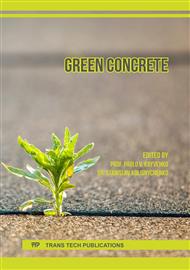[1]
Traditional Construction for a Sustainable Future:Carole Ryan 1st Edition ISBN-13: 978-0415467575.
Google Scholar
[2]
Effect of common salt on some engineering properties of eggshell stabilized Laterite soil,, APRN Journal of Engineering and applied sciences. September ,(2010).
Google Scholar
[3]
Mitigating the effect of climate change, January 2012 by JC Okonkwo, Nnamdi Azikiwe University.
Google Scholar
[4]
Egg Shell As A Fine Aggregate In Concrete For Sustainable Construction ,international journal of scientific & technology research volume 4, issue 09, September (2015).
Google Scholar
[5]
Eggshell Powder: Potential Filler in Concrete,, DOH Shu Ing, CHIN Siew Choo, 2014, Melaka, Malaysia.
Google Scholar
[6]
Scotch egg company claims to have cracked problem of eggshell waste The Guardian ,Thursday 30th June (2016).
Google Scholar
[7]
Dr. M A Nayeem: Splendour of Hyderabad, ISBN-13:1234567173789.
Google Scholar
[8]
Aishwarya Tipnis: Vernacular Traditions Contemporary Architecture, ISBN-13:978-8179934579.
Google Scholar
[9]
J.C. Harle: The Art and Architecture of the Indian Sub Continent, ISBN-13:978-0300062175.
Google Scholar
[10]
Hyderabad: Portrait of a city ISBN-13: 978-8175256767.
Google Scholar
[11]
S. K. Duggal: Building Materials, ISBN-13: 978-8122433791.
Google Scholar
[12]
Percy Brown: Indian Architecture (Islamic Period), ISBN-13: 978-1446509364.
Google Scholar
[13]
Kushala Satyanarayana: Mix Eggs, lime, herbs and voila.
Google Scholar
[14]
Glady Reyes: The Ruins Structure & Architecture.
Google Scholar
[15]
Daily Express: Mosque built from egg white and sand mixture.
Google Scholar
[16]
Victor Borges: Nasrid plasterwork: symbolism, materials & techniques.
Google Scholar
[17]
Hindustan Times, Rana Safvi: Monumental task: saving India's rich heritage.
Google Scholar
[18]
Satish Grover: Masterpieces of Traditional Indian Architecture, ISBN-13: 978-8174362933.
Google Scholar
[19]
Richard Clarke: Padmanabhapuram Palace, Magnificent Wooden Palace of Kerala.
Google Scholar
[20]
TVS INTACH: ADBHUDATIRUANTADI.
Google Scholar
[21]
Philp Davies: The Penguin Guide to the Monuments of IndiaVolume II: Islamic, Rajput, European.
Google Scholar
[22]
Rathina Sankari: Chettinad doors to a faded glory.
Google Scholar
[23]
Muzahim Al-Mukhtar: On the use of eggshell lime and taffeta powder to formulate an appropriate mortar for restoration purposes.
DOI: 10.1144/sp331.12
Google Scholar
[24]
Unknown Crafts Person Trophy Report from JBRAC 2017, National Association of Students of Architecture.
Google Scholar
[25]
Graham Mc Kay: It's Not Rocket Science #11: Keeping the Water Out.
Google Scholar
[26]
Photography Credits: Char Minar (Fig.1): Shaik Sami.
Google Scholar
[27]
Photography Credits: Qutb Shahi Tombs (Fig.2): Sheik Shahnaz Kareem.
Google Scholar



